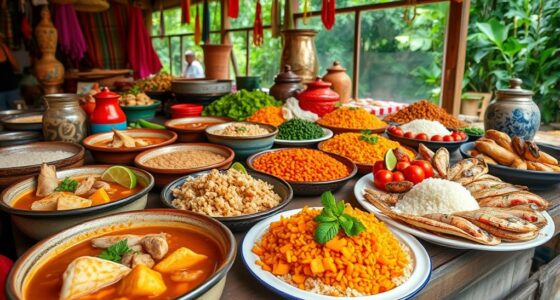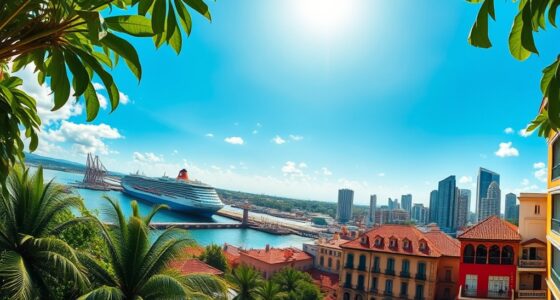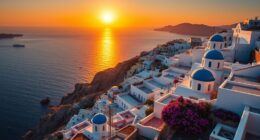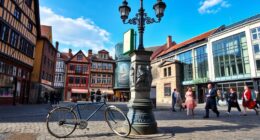Panama’s history and culture are shaped by its indigenous peoples, colonial past, and essential role in global trade. You’ll find a rich blend of indigenous traditions, Spanish influence, and African rhythms, reflected in vibrant festivals and crafts like Kuna molas and Ngäbe weavings. The Panama Canal’s control shifted from the U.S. back to Panamá in 1999, boosting national pride and modern identity. To explore more, discover how these elements continue to influence Panama today.
Key Takeaways
- Panama has a rich indigenous heritage with groups like Kuna, Ngäbe, and Emberá maintaining languages, crafts, and cultural traditions.
- The colonial era introduced Spanish influence, establishing Panama as a key transit hub and shaping its architecture and social structures.
- The Panama Canal transformed the country into a global trade center, with U.S. control impacting sovereignty until 1999.
- Panama’s cultural diversity blends indigenous, African, and Spanish influences in music, dance, crafts, and culinary traditions.
- Indigenous resistance and historical events like independence and canal control have shaped Panama’s national identity and cultural resilience.
Indigenous Foundations and Ancient Societies

Have you ever wondered how Panama’s rich history begins long before European contact? You should know that indigenous peoples inhabited the Isthmus of Panama for thousands of years. Groups like the Coclé, Ngäbe, and Kuna created vibrant societies with their own languages, crafts, and traditions. They developed sophisticated trade routes connecting Caribbean and South American communities, exchanging goods and ideas. These early societies adapted well to the tropical environment, cultivating crops like maize and manioc while building complex social structures. Their craftsmanship, from pottery to textiles, reflects rich cultural expressions that persist today. Despite the disruptive impacts of colonization, their legacies remain integral to Panama’s identity, shaping its cultural diversity and historical depth. Additionally, archaeological findings reveal ancient artifacts that provide insight into their daily lives and spiritual beliefs.
Spanish Conquest and Colonial Development

When the Spanish arrived in Panama, they quickly expanded their control, turning the region into a essential part of their empire. You see, Panama’s location made it a key hub for trade and conquest, connecting South America with Spain and Europe. Despite their dominance, indigenous resistance persisted, and the impact of colonization profoundly changed local societies.
Spanish Arrival and Expansion
The arrival of Spanish explorers in Panama marked the beginning of a profound transformation on the Isthmus. You witness their arrival, driven by the search for gold and new territories. They quickly established settlements and expanded their influence, reshaping indigenous societies. The Spanish brought new technologies, religion, and governance, often through force. Their expansion focused on exploiting resources and establishing trade routes, especially the Camino Real. This period also saw the introduction of European crops and animals, changing local ecosystems. Additionally, their influence led to the colonial development of the region, laying the groundwork for future cultural and social shifts.
Panama as Colonial Hub
As Spanish explorers established their presence on the Isthmus, Panama quickly became a crucial link in the empire’s global ambitions. You’d see it as a vital transit point for transporting gold and silver from South America to Spain, fueling economic growth. The construction of the Camino Real and the Panama Railroad transformed the region into a bustling trade hub, connecting the Atlantic and Pacific Oceans. You’d notice colonial towns like Panama City emerging as centers of administration and commerce, heavily influenced by Spanish architecture and cultural practices. Despite remote locations and resistance, the Spanish maintained control through military strength and strategic alliances. This period laid the foundation for Panama’s role in global trade, shaping its economy, society, and strategic importance for centuries to come. Additionally, the colonial era introduced Spanish influence that continues to impact Panama’s cultural landscape today.
Indigenous Resistance and Impact
Did the arrival of Spanish conquerors immediately erase the rich traditions of Panama’s indigenous peoples? Not entirely. While colonization brought disease, displacement, and cultural suppression, indigenous groups like the Ngäbe, Kuna, and Coclé resisted fiercely. They fought to preserve their lands, languages, and customs, often hiding traditions in secret or blending them with colonial practices. Some communities maintained autonomous zones, resisting colonial authority and maintaining spiritual and social practices. Their impact persisted through craftwork, oral histories, and cultural festivals. Even under colonial rule, indigenous resilience shaped Panama’s history. Additionally, their efforts to maintain cultural identity continue to influence modern Panama. Today, their influence endures in language, art, and social structures, reminding you that resistance was ongoing and essential in shaping Panama’s diverse identity. Their legacy remains a testament to endurance amid adversity.
Path to Independence and Early National Identity
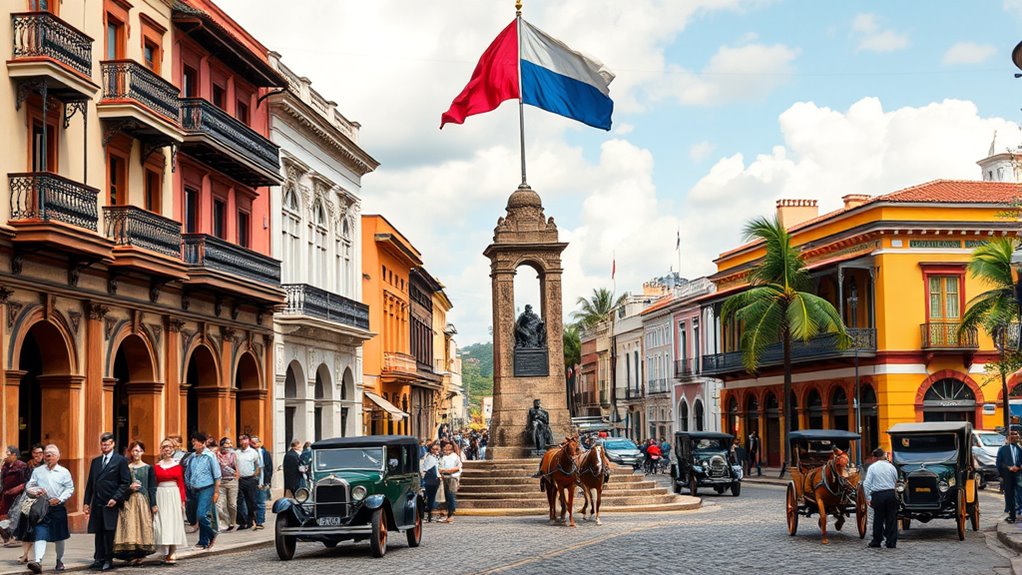
What sparked Panama’s journey toward independence and the formation of its national identity? It was a mix of local frustrations, strategic location, and external influences. You see, Panama’s position made it a key transit point, fueling economic interests and political tensions. The desire for autonomy grew as Panama opposed distant Bogotá’s control, especially after independence from Spain in 1821. The U.S. also played a role, with treaties in 1846 and the construction of the Panama Railway, highlighting growing foreign influence. These factors fueled early efforts to define Panama’s identity beyond colonial ties. Here’s a quick overview:
| Key Factors | Influences | Outcomes |
|---|---|---|
| Local resistance | Spanish legacy | Calls for independence |
| Strategic location | U.S. involvement | Rise of national pride |
| Economic interests | Colombia’s control | Movements for autonomy |
| External treaties | Panama Railway | Early push for sovereignty |
Additionally, the development of a distinct Panamanian identity was reinforced by cultural exchanges and the desire to distinguish itself from its colonial past.
The Panama Canal: Catalyst of Global Trade and U.S. Influence
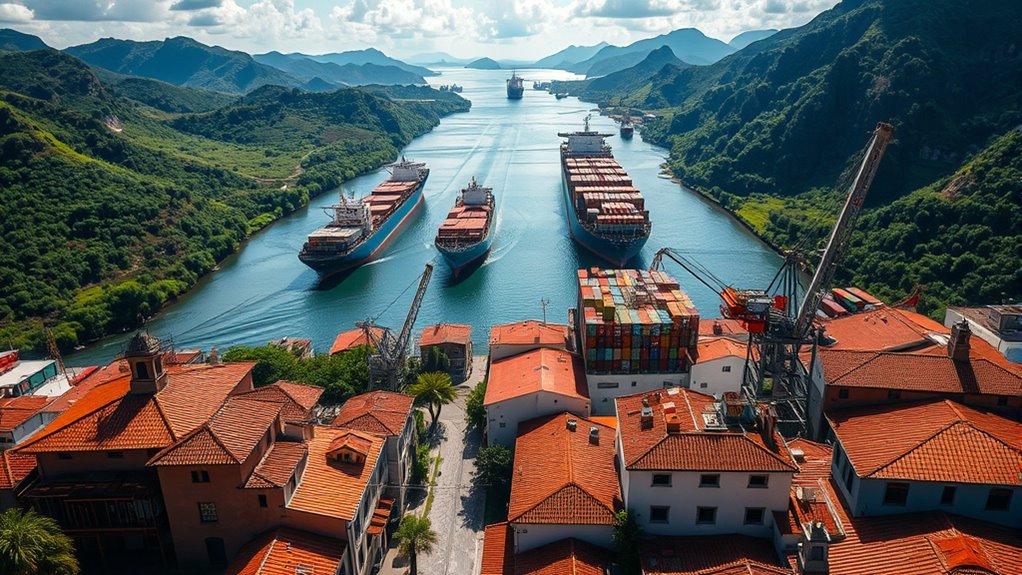
The construction and control of the Panama Canal transformed Panama from a regional crossroads into a pivotal hub for global trade. You see, the canal shortened shipping routes between the Atlantic and Pacific oceans, boosting international commerce and making Panama a key player in world markets. The United States played a crucial role in building the canal, asserting its influence over Panama’s sovereignty through treaties like the Hay-Bunau-Varilla. This control lasted for decades, shaping Panama’s political and economic landscape. The canal’s strategic importance brought U.S. military and economic presence, fueling both development and tension. When Panama eventually regained control in 1999, it marked a significant shift toward sovereignty. Today, the canal remains an essential artery for global trade and a symbol of Panama’s resilience and growing independence. Fresh insights into the canal’s operation and maintenance highlight its ongoing significance in international logistics and signs of spoilage, underscoring the importance of its proper management and preservation.
Political Turmoil and Military Rule
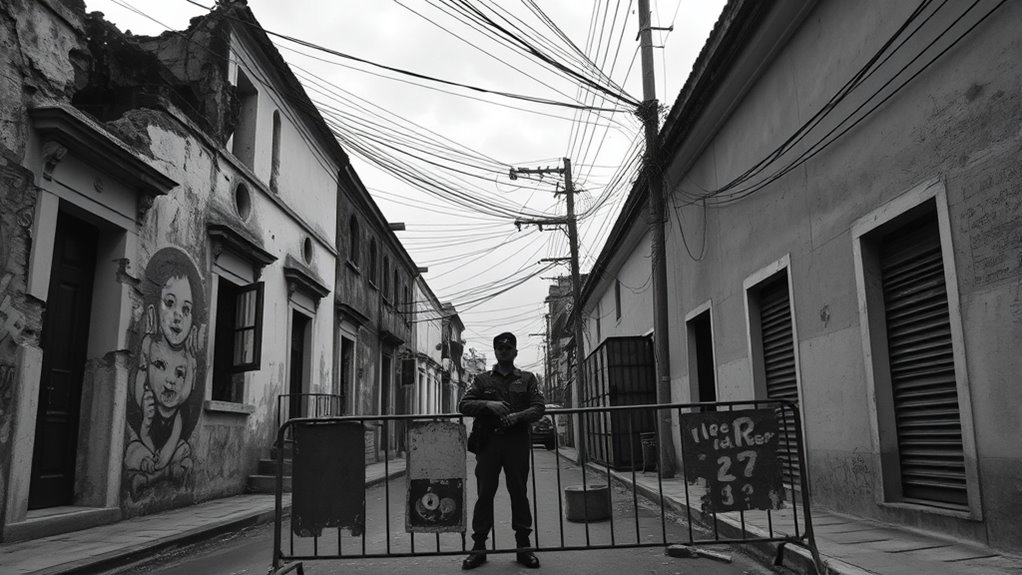
Amid ongoing political instability, Panama experienced a series of military coups and authoritarian regimes that deeply impacted its democracy. In 1968, General Omar Torrijos led a coup, establishing a military dictatorship focused on nationalism and social reforms. Torrijos negotiated the 1977 treaties, returning the Panama Canal to Panamanian control and boosting national pride. In the 1980s, Manuel Noriega rose to power through the Panama Defense Forces, ruling as a military dictator. His regime was marred by corruption, drug trafficking allegations, and strained U.S. relations. The United States responded by invading Panama in December 1989, deposing Noriega and restoring civilian governance. This period of turmoil left a lasting mark on Panama’s political landscape, shaping its path toward stability and democratic development.
The Return of the Canal and Modern Political Changes
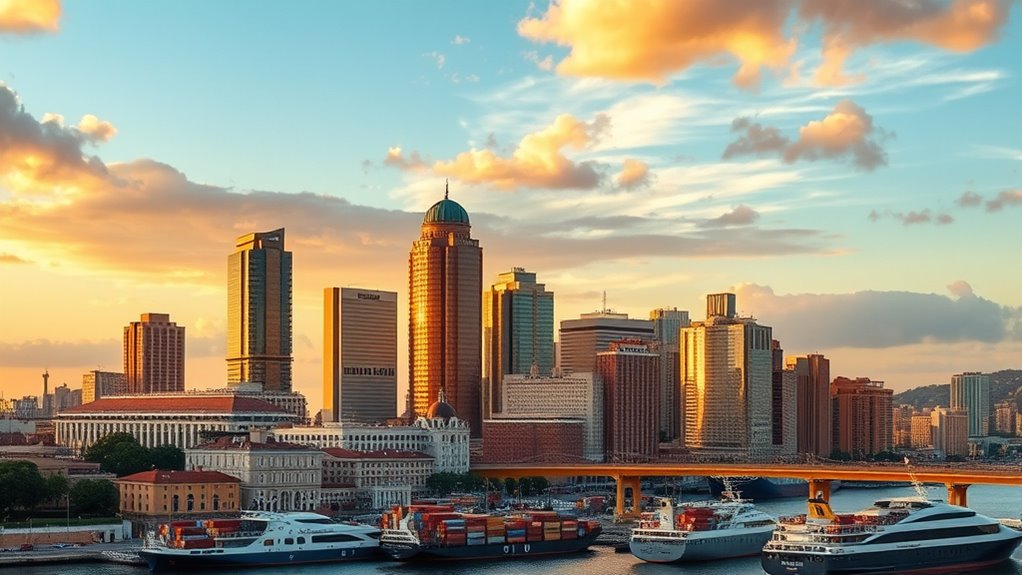
Following decades of U.S. control, Panama regained full sovereignty over the Panama Canal through the Torrijos-Carter Treaties signed in 1977. These treaties set a timeline for transferring control, which occurred on December 31, 1999. This shift marked a major political milestone, empowering Panama to manage its essential waterway and assert national independence. The transfer boosted Panama’s international standing and fueled economic growth, as the canal remains central to global trade. Politically, Panama experienced increased stability and a move toward democratic governance after years of military rule. The return of the canal also fostered a renewed sense of pride among Panamanians, strengthening national identity. Today, the canal symbolizes Panama’s sovereignty, resilience, and its strategic importance in world commerce. Notably, the canal’s operation and management continue to evolve, reflecting Panama’s ongoing economic development.
Cultural Diversity and Indigenous Heritage
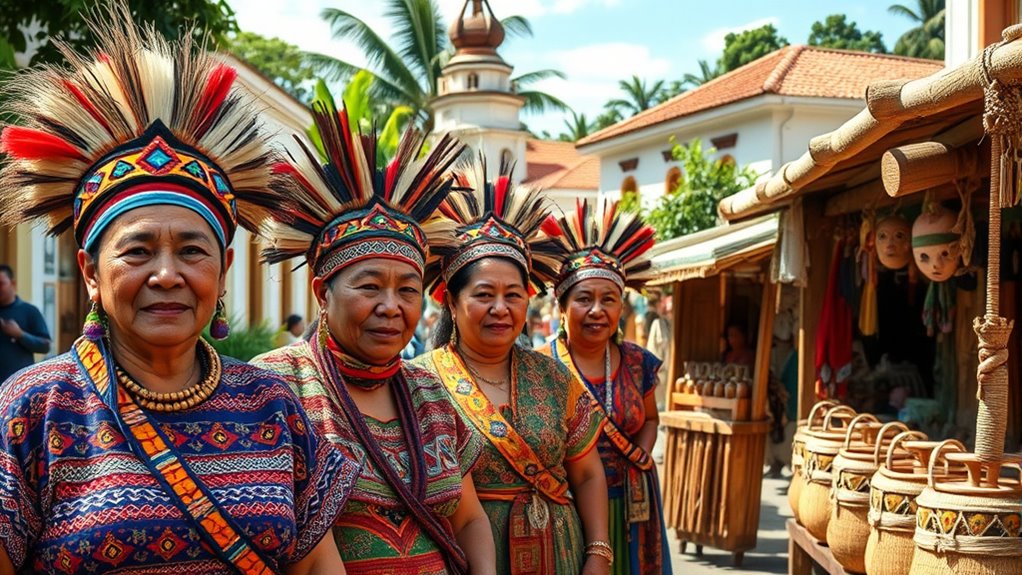
Panama’s rich cultural mosaic reflects a vibrant blend of indigenous traditions, African influences, and Spanish heritage that shape its national identity. You’ll notice this diversity in the art, language, and social customs that persist today. Indigenous groups like the Kuna, Ngäbe, and Emberá maintain unique crafts, such as textiles, beadwork, and wood carvings, which highlight their cultural resilience. Their languages are still spoken in many regions, preserving ancestral knowledge. Afro-Caribbean communities contribute lively music, dance, and culinary traditions, enriching Panama’s cultural landscape. Spanish remains the official language, but regional indigenous languages and Afro-Caribbean creoles add to the linguistic diversity. This blend of traditions creates a dynamic society where historical roots and modern expressions coexist, celebrating a shared identity rooted in multicultural heritage.
Artistic Traditions and Cultural Expressions
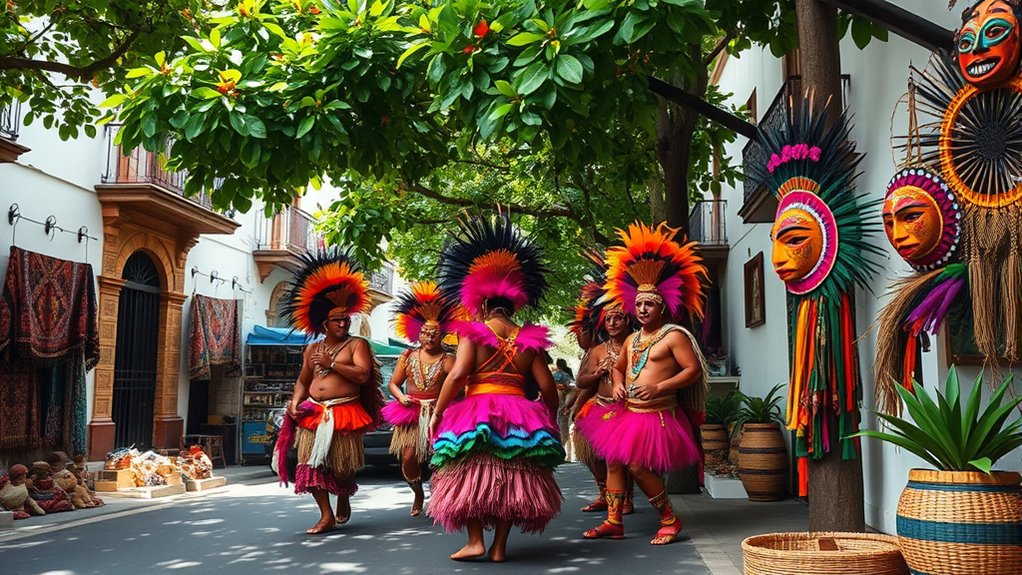
You can see Panama’s rich artistic traditions in its vibrant crafts and textiles, which carry indigenous stories and gender roles. Music and dance also express a blend of cultural influences, from African rhythms to indigenous melodies. These artistic expressions connect Panama’s history with its lively present, showcasing its diverse cultural identity. Additionally, traditional modern farmhouse elements can sometimes be found in contemporary Panamanian interior designs, blending heritage with modern aesthetics.
Indigenous Crafts and Textiles
Have you ever noticed the vibrant textiles and intricate woodwork that showcase Panama’s indigenous artistic traditions? You’ll see Kuna molas, layered fabrics with bold geometric designs, symbolizing their cultural stories. Ngäbe weavings often feature bright colors and patterns reflecting their connection to nature and spiritual beliefs. Kuna and Emberá artisans craft detailed beadwork, baskets, and embroidered clothing, emphasizing gender roles and community identity. These crafts are more than decorative; they serve as cultural symbols and storytelling tools. Traditional techniques are passed down through generations, maintaining their authenticity despite modern influences. You can find these textiles and crafts in local markets, offering a vivid glimpse into Panama’s rich indigenous heritage and the resilience of their artistic expressions. Additionally, the celebrity lifestyle insights reveal how contemporary artists incorporate traditional motifs into modern design, helping to preserve and promote indigenous art forms globally.
Music and Dance Traditions
Did you know that Panama’s music and dance traditions vividly reflect its diverse cultural tapestry? You’ll find lively rhythms and energetic dances rooted in Indigenous, African, and Spanish influences. The traditional tamborito stands out with its rhythmic drumming and spirited choreography, often performed during festivals like Carnaval. The cumbia, a popular dance style, blends African and Hispanic elements, showcasing graceful movements and vibrant music. Afro-Panamanian genres like reggae en Español and dancehall express the island’s Afro-Caribbean heritage, pulsating through city streets and festivals. Indigenous communities preserve their musical traditions through ceremonial songs and dances performed with drums, flutes, and traditional attire. By participating or observing, you connect with Panama’s cultural history, where music and dance serve as powerful expressions of identity and resilience. Traditional music and dance continue to evolve while maintaining deep roots in Panama’s rich cultural history.
Contemporary Panama: Society, Festivals, and Identity
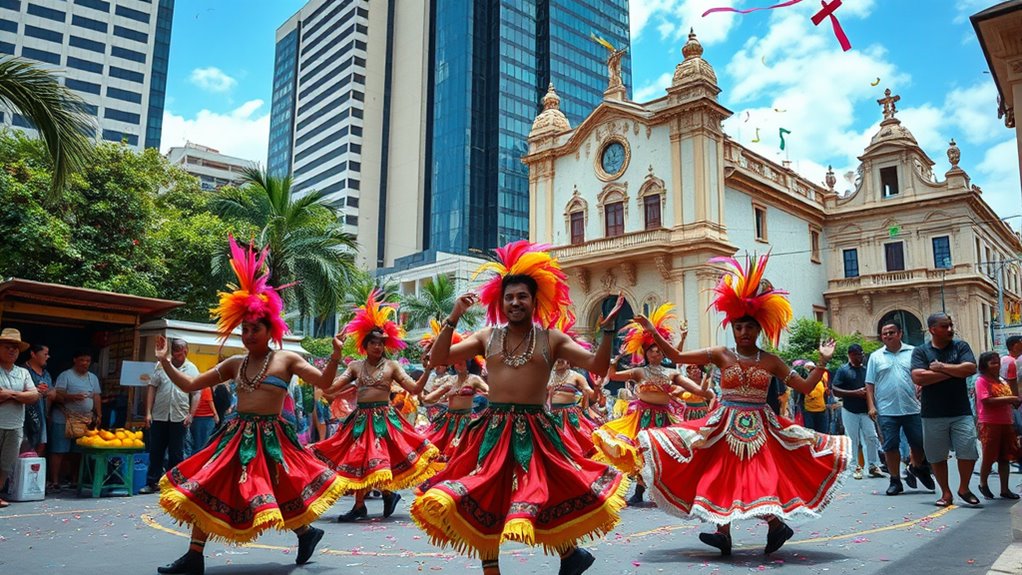
Contemporary Panama is a vibrant tapestry of diverse cultures, where indigenous traditions, Afro-Caribbean influences, and Spanish heritage blend to shape a unique national identity. You’ll notice this diversity in lively festivals like Carnaval, where colorful costumes and rhythmic music celebrate centuries of cultural fusion. Local communities preserve indigenous crafts, such as Kuna textiles and Emberá woodwork, highlighting their enduring cultural pride. Panamanians take pride in their national symbols, like the flag and the Panama Canal, which symbolize resilience and progress. Spanish remains the official language, yet regional languages and Afro-Caribbean creoles thrive, reflecting the country’s multicultural roots. Society embraces a mix of modernity and tradition, fostering a sense of unity rooted in shared history, community celebrations, and a resilient spirit that defines Panama today.
Frequently Asked Questions
How Do Indigenous Communities in Panama Maintain Their Cultural Traditions Today?
You can see indigenous communities in Panama maintaining their cultural traditions through vibrant crafts like Kuna textiles and Emberá woodwork, which they actively preserve and sell. They speak their native languages, practice traditional dances, and celebrate festivals that honor their heritage. Many also pass down stories, rituals, and social customs to younger generations, ensuring their unique identities stay alive despite modern influences. This ongoing cultural expression keeps their traditions resilient and relevant today.
What Role Did the Panama Railroad Play in Regional Development During the 19TH Century?
The Panama Railroad played a crucial role in regional development during the 19th century by connecting the Atlantic and Pacific Oceans, making trade and travel much faster and more efficient. You benefit from increased commerce, which boosts local economies and fosters cultural exchange. It also helped establish Panama as a key transit hub, attracting investment and encouraging infrastructure growth, ultimately shaping the country’s strategic importance in regional and global trade networks.
How Did U.S. Control Over the Canal Zone Influence Panama’s Economy and Politics?
Think of Panama’s economy and politics like a ship steering through turbulent waters—U.S. control over the Canal Zone was the anchor. It boosted Panama’s trade, making it a global hub, but also limited sovereignty. You saw this firsthand in 1977, when the Torrijos-Carter Treaties promised eventual control back to Panama. Until then, U.S. influence shaped policies, economy, and national pride, often creating a tug-of-war for independence.
What Are the Main Influences Behind Panama’s Vibrant Music and Dance Festivals?
You find that Panama’s vibrant music and dance festivals are shaped by a mix of indigenous, African, and Spanish influences. The indigenous traditions contribute unique rhythms and costumes, while African heritage brings lively beats and dance styles. Spanish colonization introduced festive customs and instruments. Together, these diverse cultural elements blend into lively celebrations like Carnaval and Pollera dances, reflecting Panama’s rich, multicultural identity and deep-rooted traditions.
How Has Panama’s Diverse Heritage Shaped Its National Identity in Modern Times?
Imagine a tapestry woven from indigenous, African, and Spanish threads—that’s how Panama’s diverse heritage shapes your national identity today. You see this in vibrant festivals, lively music, and colorful crafts that reflect your country’s rich cultural blend. This fusion fosters pride and unity, reminding you that Panama’s strength comes from embracing its multifaceted past, creating a unique identity that celebrates all its peoples and traditions.
Conclusion
You see Panama’s rich history—ancient tribes and colonial struggles—shaping a vibrant, diverse nation. Amid progress, echoes of conflict remind you of resilience. The canal’s bustling trade contrasts with indigenous traditions preserved through art and festivals. As modern Panama evolves, it balances the weight of its past with hopes for the future. You feel inspired by its strength—an enduring spirit that unites history and hope in every heartbeat.




